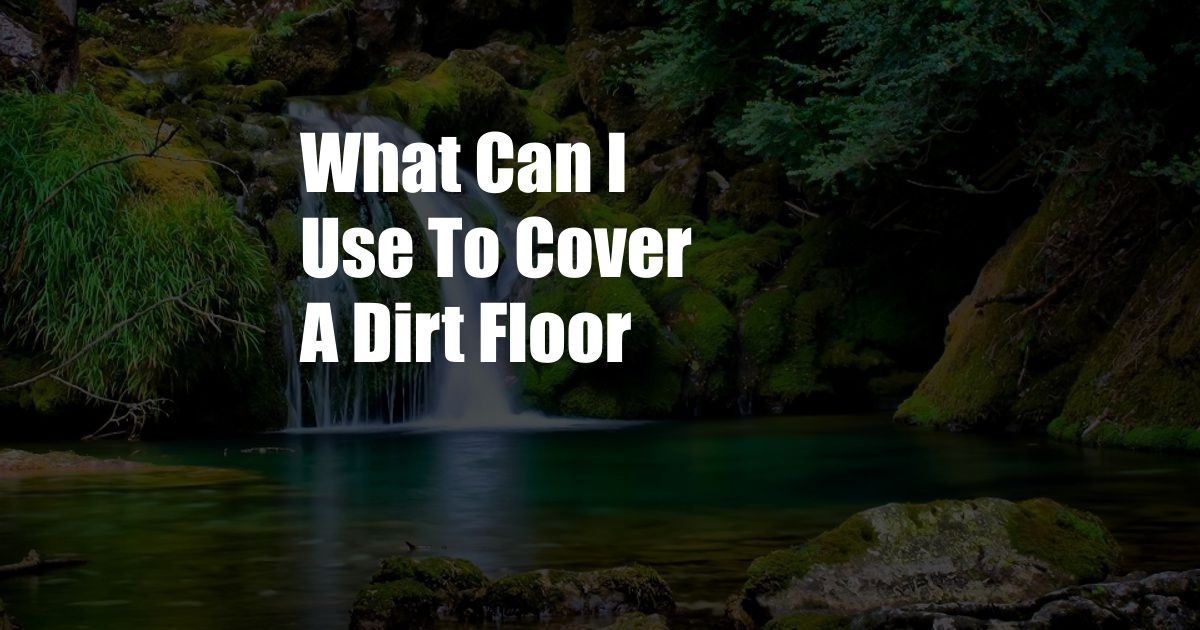
What Can I Use to Cover a Dirt Floor?
I can still recall the earthy scent and feel of the bare dirt floor as a child. It was a constant reminder of our humble beginnings and the hard work that went into maintaining our home. While dirt floors may have a certain rustic charm, they can also be dusty, cold, and damp, especially in humid climates. Fortunately, there are plenty of options available today to cover a dirt floor and improve the comfort and livability of your space.
Before settling on a specific covering, it’s essential to assess the condition of the dirt floor and the desired outcome. Is the floor level and packed, or are there significant dips and bumps? Do you want a permanent solution, or are you looking for something more temporary? These considerations will help you narrow down your options and choose the best material for your needs.
Types of Dirt Floor Coverings
Polymer Flooring
Polymer flooring is a type of epoxy resin that is applied liquid and dries to form a durable, seamless surface. It is highly resistant to moisture, chemicals, and abrasion, making it an excellent choice for areas subjected to heavy traffic or moisture. Polymer flooring can be customized with a variety of colors and textures, allowing for a wide range of design options.
While polymer flooring is a durable and long-lasting solution, it can be more expensive than other options and requires professional installation. It is also not a DIY-friendly project and should be left to experienced contractors.
Concrete Overlays
Concrete overlays are another popular option for covering dirt floors. They involve applying a thin layer of concrete over the existing surface, creating a smooth and level finish. Concrete overlays are relatively inexpensive and can be installed by DIYers with basic concrete-working skills.
One disadvantage of concrete overlays is that they can crack or chip if the underlying dirt floor is not properly prepared. Regular maintenance, such as sealing and patching, is also required to extend their lifespan.
Sheet Vinyl Flooring
Sheet vinyl flooring is a budget-friendly and easy-to-install option for covering dirt floors. It is made from a durable synthetic material that is resistant to moisture and stains, making it a practical choice for kitchens, bathrooms, and other areas where spills and dirt are common.
Sheet vinyl flooring is available in a wide range of patterns and colors, allowing you to customize the look of your space. It is also relatively easy to clean and maintain, requiring only regular sweeping and mopping.
Raised Flooring Systems
Raised flooring systems are a more expensive but effective way to cover a dirt floor and create a level, moisture-resistant surface. They involve installing a grid of adjustable pedestals over the dirt floor and then placing modular tiles or panels on top.
Raised flooring systems provide excellent ventilation, reducing moisture buildup and the risk of mold and mildew. They are also easy to access, allowing for easy maintenance and repair of utilities beneath the floor.
Tips for Covering a Dirt Floor
- Prepare the Floor: Before applying any covering, ensure the dirt floor is level, packed, and free of debris. If necessary, use a tamper or compactor to level the floor and remove any loose dirt.
- Use a Moisture Barrier: In areas prone to moisture, install a moisture barrier between the dirt floor and the covering to prevent moisture from wicking up and damaging the material.
- Enhance Insulation: If desired, add a layer of insulation between the dirt floor and the covering to improve the thermal comfort of the space, especially in cold climates.
- Secure the Covering: Use appropriate adhesives, fasteners, or weights to secure the covering to the dirt floor, preventing it from shifting or moving.
- Finish and Protect: Once the covering is installed, apply a protective finish or sealant to enhance its durability and protect it from wear and tear.
FAQs on Dirt Floor Coverings
- Q: How long does it take to cover a dirt floor?
A: The time it takes to cover a dirt floor depends on the size of the area, the condition of the floor, and the chosen covering material. Generally, smaller areas with a level dirt floor can be covered in a few hours to a day, while larger areas or floors with uneven surfaces may take longer. - Q: Can I cover a dirt floor with carpet?
A: While it is possible to cover a dirt floor with carpet, it is not recommended. Carpet can trap moisture and dirt, creating a breeding ground for mold and mildew, especially in damp environments. Sheet vinyl flooring or other moisture-resistant materials are more suitable for covering dirt floors. - Q: How do I maintain a covered dirt floor?
A: The maintenance of a covered dirt floor depends on the type of covering used. Generally, regular sweeping or mopping is sufficient for most materials. Some coverings, such as polymer flooring, may require periodic resealing to maintain their durability.
Conclusion
Covering a dirt floor is a great way to make a space more comfortable, hygienic, and aesthetically pleasing. Whether you choose a durable polymer floor, a budget-friendly sheet vinyl, or a flexible raised flooring system, there are numerous options available to suit your specific needs and preferences. By following the tips and advice outlined in this article, you can successfully cover your dirt floor and transform your space into a more livable and enjoyable environment.
Would you like to learn more about dirt floor coverings or explore other flooring options? Leave a comment below and let’s continue the conversation!